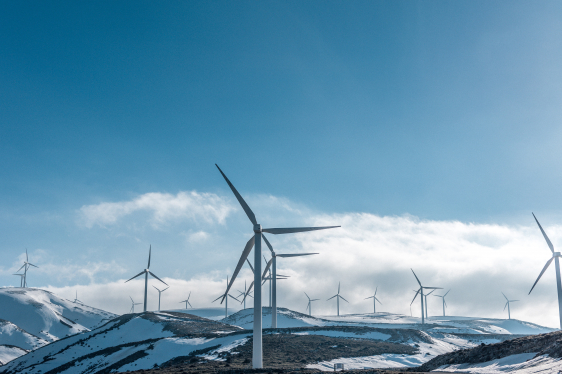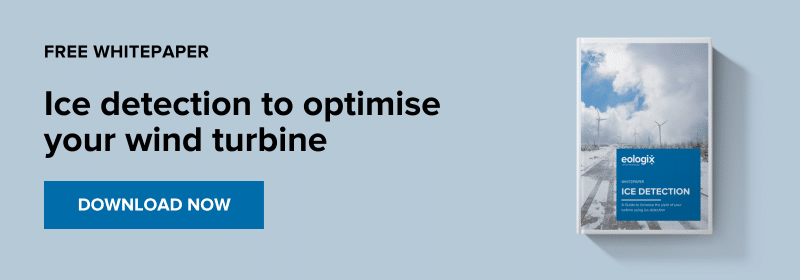TECHNOLOGY | 5 MIN TO READ
Types of ice detection systems
Whitepaper: Optimise your wind turbine by using ice detection

What are the options for ice detection?
There are a variety of systems for the detection of ice on the rotor blades or rather technologies for the detection of icing. Most frequent ones:
- Measurement of the ambient temperature
- Measurement of the ambient temperature and the humidity
- Anemometer comparison
- Nacelle-based ice detectors
- Camera systems
- Ice detection via a change of the performance curve
- Ice detection using measurements directly on the rotor blades
Due to the measurement methodology and the associated accuracy, the methods mentioned above differ in addition to the factors of the yield of the wind turbine and the wear and tear in the safety factor. Therefore, two technical solutions have become established on the market: nacelle-based ice detection systems and ice detection systems on rotor blades.
Nacelle-based ice detection systems
Nacelle-based ice detection systems determine on the nacelle whether the conditions for icing of the rotor blades are met. There are different approaches:
- Comparison of two anemometers
- Ultrasound-based ice detection
- Acquisition of meteorological data such as humidity
It is common to all approaches that there are different flow conditions on the nacelle than on the rotor blade, since rotor blades reach higher heights and the flow (high top speeds) on the blade results in different flow conditions.
Ice detection systems on rotor blades
Ice detection on rotor blades determines icing by measuring directly on the rotor blade or inside the rotor blade. A distinction is made between direct measurement on the outside of the blade (e.g. fully automatic operation under icing conditions with eologix:restart) and systems that measure indirectly inside the blade.
What is the difference between nacelle-based ice detection systems and the direct measuring of the eologix systems?
As already shown, nacelle-based ice detection systems (i.e. Labkotec, work, for example, by comparing two anemometers, ultrasound-based measurement or the acquisition of meteorological data, such as humidity, whether there are icing conditions and therefore the system must be switched off.
However, there are other flow conditions on the nacelle than on the rotor blade. These are due to the rotation of the rotor blades and due to the differing altitude. Especially because of the trend towards ever larger rotor blades and increasing tower heights, an ever-greater impact is also foreseeable in the future.
Because of these properties of the rotor blades, the sensors must be designed to be sensitive in order to be able to reliably detect an accumulation of ice. However, this can lead to the system being switched off earlier than would actually be necessary. Furthermore, the measurement on the nacelle cannot determine when the icing on the rotor blades has ended. Automatic restart, as for example with our eologix:restart system, is therefore not possible with such systems.
What is the advantage of measuring directly on the rotor blade surface?
There are systems that enable ice detection and temperature measurement directly on the blade surface of wind turbines. This measurement directly on the blade surface enables exact detection and does not require any electrical wiring inside the blade. It does not interfere with the construction of a wind turbine as no service work is required inside the blade.
Due to the measurement directly on the rotor blade surface, a measurement at the tip of the rotor blade is also possible. This is advantageous, as this is where icing usually begins. Ice detection systems which measure indirectly inside the blade cannot do this, as such systems are usually not accessible due to the structure of the blade.
For ice detection systems directly on the rotor blade, the ice signal can be calculated without access to the operating data of the wind turbine. In contrast, vibration-based systems require operating data of the wind turbine such as wind speed, pitch angle, number of revolutions etc.
By using energy-autonomous sensors, ice detection systems directly on the blade surface do not cause any further running costs. Furthermore, measurement is possible during complete standstill, which means that no wind excitation is necessary to set the blades into vibration.
What systems are available on the market and how do they differ?
Which systems are available on the market and how they differ is explained in detail in our 21-page whitepaper about ice detection to optimise your wind turbine.
eologix sensor technology gmbhH offers systems for ice detection with direct measurement on the rotor blades based on capacitive sensor technology and stands for ice detection and temperature measurement directly on the rotor blade surface. When selecting an ice detection system, various factors must be taken into account, including the calibration and flexibility of the solution. Here you will find an overview of 6 relevant factors to consider when purchasing an ice detection system.
eologix offers ice detection systems consisting of one receiver unit per system and flexible, energy-autonomous and precise sensors, which are mounted directly on the blade surface. Learn more about the eologix systems.







